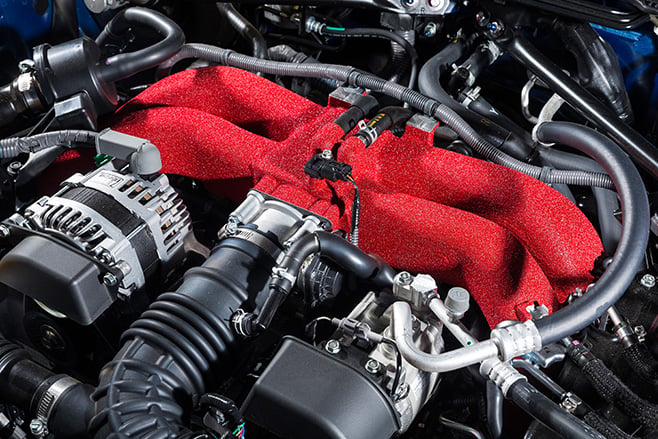Australia’s romance with the rear-drive car is well documented. We all have our own rear-drive memories – fondly recalled for different reasons.
Whether it’s regrettable flashbacks of single-spinner action in your mate’s VN Commodore as a red P-plater; or the first time you planted the throttle in a deserted shopping centre car park at 11.30pm, to feel the rear step out only to end up facing the wrong way, stalled, your heart pounding as a security guard in a Hyundai Getz came chasing after you…
Or perhaps it was the time you finally had an adult income and purchased your first power-packed rear-tyre-fryer – and, with a few track days under the belt, nailed that first drift, that sublime feeling as you successfully balanced throttle and steering and felt like a god.
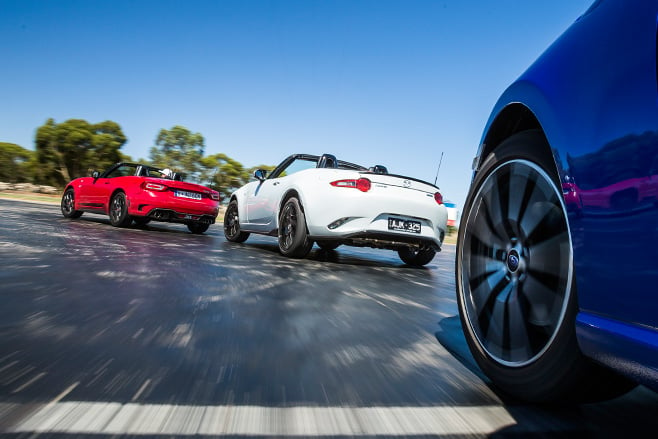
Cars like the Ford Mustang GT and, though still some years away, Chevrolet Camaro, promise to feed our addictions, along with newbies like Kia’s surprising 272kW Stinger GT. But you don’t need to shell out fifty or sixty large to get that rear-drive feeling with the new car smell – budget back-axle action is taking off in ways we’ve not seen since we farewelled the Nissan Silvia in 2002.
Of course, you couldn’t say it all restarted with the revelatory Toyota 86 and Subaru BRZ twins which, when they arrived in 2012, promised proper, affordable rear-drive thrills, because the Mazda MX-5 has been offering this all along. The thing with the MX-5, though, is that rear-drive has almost seemed a functional piece of its makeup, rather than a character-defining part of its appeal.
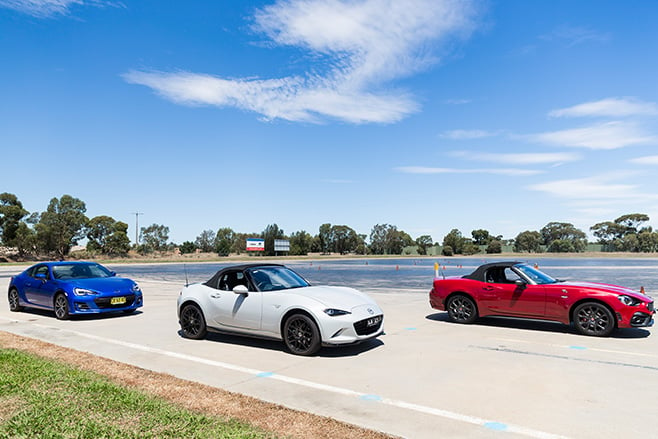
And for the first time, you can now get a factory turbo MX-5 – a global product, not a skunkworks car (like the Aussie-only turbo NB SP and SE). The only thing is, it’s not a Mazda. A quirk of two otherwise disparate car companies working together, Fiat now sells the Abarth 124 Spider – effectively a restyled MX-5 with a completely different engine, a turbocharged 1.4-litre four-cylinder – and with a totally different personality.
This sudden variety of pretty affordable rear-driven funboxes is all great news for anyone pining for a lone tailshaft under the centre console. To the point that, you might have a decision to make. We’re here to help.
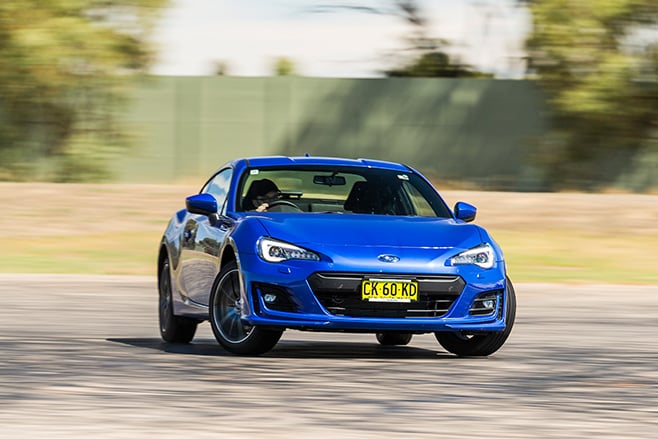
Power is also up, but only 5kW/9Nm, from the 2.0-litre horizontally opposed atmo four-cylinder, now 152kW and 212Nm. And the good news is, the price is down: $1230 less than the 2016 model, now $32,990 for the base manual.
The interior has also received some attention with new infotainment software, an attractive new steering wheel and a cool TFT display showing off vital mechanical signs in the instrument binnacle. And why we’d pick this over a Toyota 86? We always use that car for stuff like this and it was time to give the Subie some love.
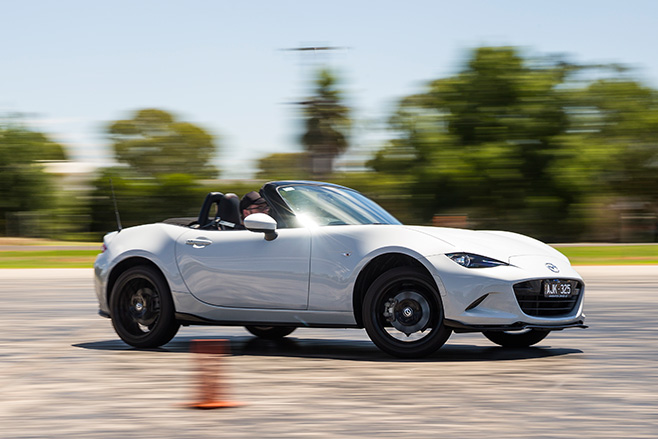
Packing a rorty 2.0-litre SkyActiv high-compression (13:1) nat-atmo four-cylinder, the ND belts out 118kW at 6000rpm and 200Nm at 4600rpm. Less than the BRZ, but the MX-5 has only 1033kg to shift compared to the Subie’s 1242kg. Of course, the MX-5 is also a smaller car.
It’s smaller, too, than Fiat’s Abarth-enhanced 124 Spider. At $41,990, our red contender is the most expensive here and surprisingly, a whopping 139mm longer than the MX-5, a lot of it presumably down to the more pointy front and rear bars.
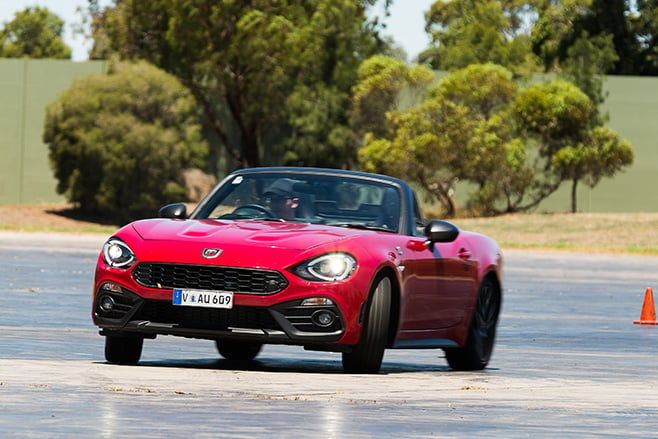
Though at 114kW/tonne, the MX-5 takes the wooden spoon for power-to-weight – the BRZ’s 122kW/tonne pipping the 124’s 118kW/tonne – interestingly, the MX-5 is the fastest car here in a straight line. On a warm and sunny day at the dragstrip, 4600rpm produces the best launch in the MX-5, bringing home the goods with a 14.9sec quarter at 149km/h, and a 6.7sec 0-100km/h.
Next up the snorting 124 Spider needs a surprisingly large amount of revs (5500rpm) to avoid bogging down and asks for a lightning-fast one-two shift just before the limiter for a best of 15.0sec at 148.7km/h, and 0-100km/h in 6.9sec. Abarth claims 6.8sec.
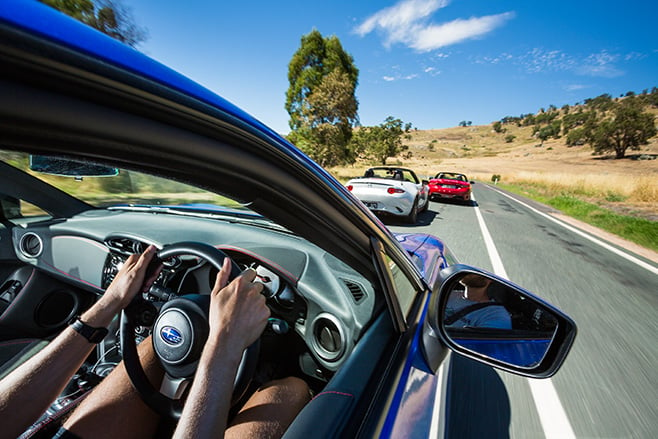
The numbers, too, tell a story of the 124 greatly benefiting from its turbocharged mid-range muscle, the best overtaker here. Put all cars in their top gears and nail it, and though they’ll be groaning against lower revs, it’s interesting that the 124 takes 8.6sec to cover the 80-120km/h rolling sprint in sixth gear, compared to the MX-5’s 11.5sec and the BRZ’s 11.6sec.
It’s turbocharging that gives the 124 Spider a completely different personality to the two other cars here. With the 124’s mid-range turbo torque you can lazily surf, making its grunt the most flexible, usable and versatile of our three. It’s enormous fun in the urban environment where it’s not possible to rev out every gear. Particularly because of the noise.
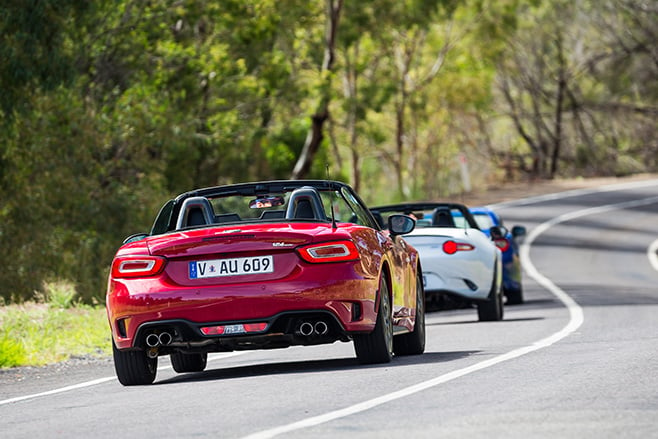
Though it sounds the best, the 124’s engine is not the best engine here – that honour goes to the MX-5’s. When you’re not having to stop at a red light or gun around a 90-degree corner every 100 metres, the open road invites using all of the engine’s performance and this is where the MX-5’s 2.0-litre nat-atmo four shines.
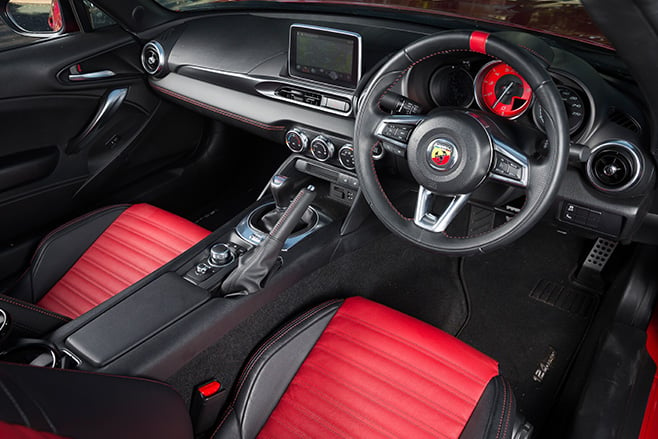
Interestingly, with the roof down in both cars, as wind noise rises and starts to muffle the Fiat’s exhaust, it’s the MX-5’s induction noise that makes it the more involving to the ears at speed.
By comparison to both engines, the BRZ’s boxer four has never felt more emotionless and functional – although if you ask this tester, the BRZ/86 engine gets a bad rap. Around town, below 5000rpm, it’s flat and lazy, and sounds a bit off.
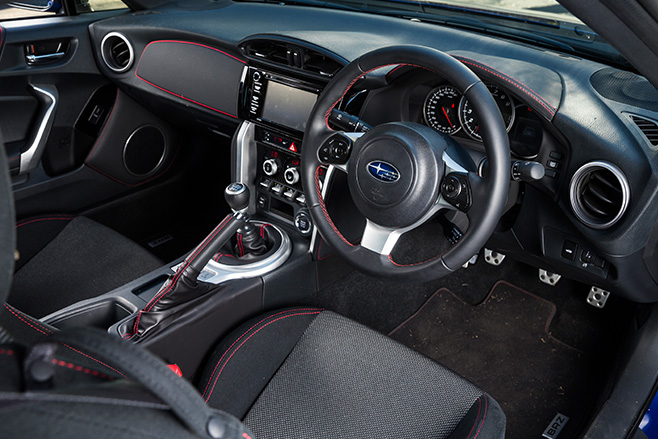
That’s because the BRZ remains the best, most satisfying driver’s car here. If you’ve ever gotten up at 5am just to go for a good drive, the BRZ remains your car. Its steering is still the best in the business, well-judged rack speed combining with fantastic feel and perfect weighting for an incredibly communicative and satisfying front end.
But what Subaru has done, and Toyota too with the 86, is bin an out-dated and unsuitable electronic stability program in place of something both cars – and their excitable rear axles – have been crying out for since day dot.
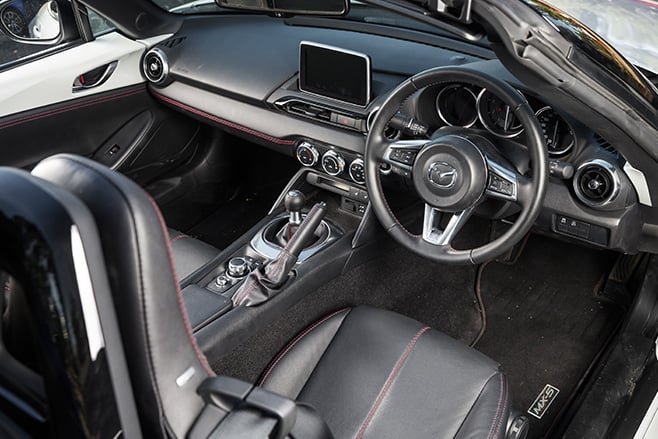
On the same twisty road, however, the MX-5 will have you pulling over to think in ways the BRZ won’t. It is a car that requires considered inputs to get the best out of and enjoy, owing mostly to its incredibly soft – relatively speaking – suspension.
Such is its extremely exaggerated and languid body-roll that the ND MX-5 would feel like a clown car to anyone who’s used to rock-hard coilovers with no body-roll. Pin the MX-5’s throttle and the nose visibly lifts. Hit the brakes and the MX-5 noticeably dives. Start turning and the car leans on to its outside tyres.

At the same time, the MX-5 is intolerant of scrappy, overly aggressive driving, getting upset if you ask too much of it, too abruptly. To the point that you need to know how to smoothly mop up a mistake prior to turning off its ESP, otherwise it’ll snap back the other way and put you in a ditch before you knew it. In this way, the MX-5 can be a deceptively bitey car. And that is one of its small issues: the ESP comes in two settings, on and off.
While the ESP doesn’t feel particularly intrusive in the MX-5, it’s in the 124 that you find yourself wishing there was a half-off setting. With slightly stiffer springs somewhat taming the MX-5’s surprise oversteer fetish, and with all that low-down torque, this is a car you’ll be searching for uphill hairpins in. It’s just a shame that you’ll need to turn the ESP all the way off for any throttle-invoked action. And as the 124’s handling is fundamentally the same as the MX-5’s, you don’t turn the ESP off lightly.
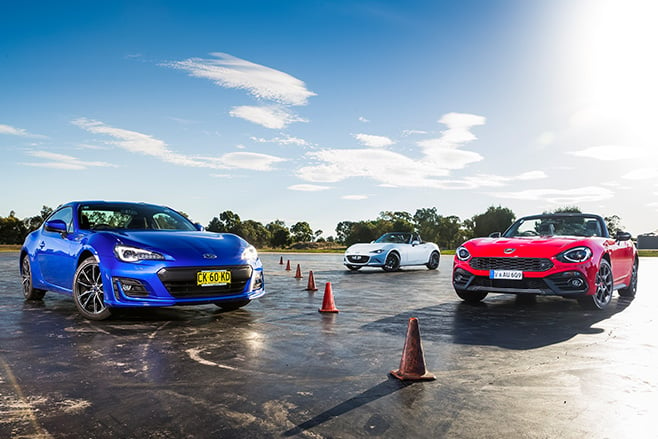
On a bewitching stretch of driving road with nothing but empty bitumen, you and a steering wheel? This is where the 124 slipped to third. While its engine is a downright laugh at lower speeds, on the open road with the roof down, the exhaust starts to become muted by wind noise at speed, and then you’re just left with an engine that feels a little breathless in its top end compared to the MX-5’s.
Thanks to an outstanding chassis and steering – and finally electronics to match – the Subaru is still the best car here for the hardcore driver. But the same driver will be beguiled by the MX-5’s exciting, old-school handling – and, crucially, invigorated by its keen, perky and revvy engine. All three cars on this test are truly excellent in their own ways, and will each appeal to different people, but for us, the MX-5’s combination of exciting chassis and engine – and top-down potential – means we’d grab its keys for the long, fast drive.
May the rear-drive romance continue.
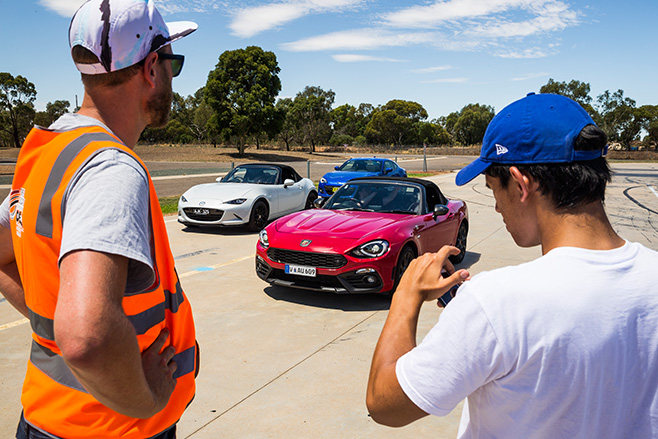
Second Opinion
Other road testers donate their two cents
LOUIS CORDONY – STAFF JOURNALIST IT DOESN’T matter which one you snaffle the keys to, any of these three bring big smiles. I loved the Abarth’s maniacal exhaust note and, interestingly, it has a rear-view camera and lane change alert – missing on the Mazda. But the Mazda’s atmo engine breeds a more endearing character, and its face is much easier to love than its Italian twin. The reasons you’d pick the BRZ over either comes down to its cargo space and sharper chassis. The former makes it easier day to day, while the latter pays on the weekend.
TIM VAN DUYL – DIEHARD ENTHUSIAST FIRST OFF, I can’t stomach the Abarth’s interior. The 80s need be left where it is, in the past. As a former MX-5 owner I gravitate to the ND, but ultimately my two metre frame isn’t very compatible. Would I recommend one to someone? In a heartbeat. Its engine is smooth, effortless, and is matched to nice gear ratios. But the BRZ’s my pick. Had it an engine like the ND, it would be near perfect. The BRZ’s confident attitude under brakes, its low slung feel, the high doors and tall dash make it feel fast even sitting at lights.
Specs
